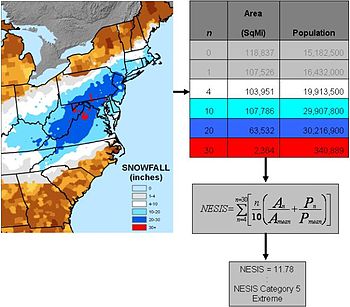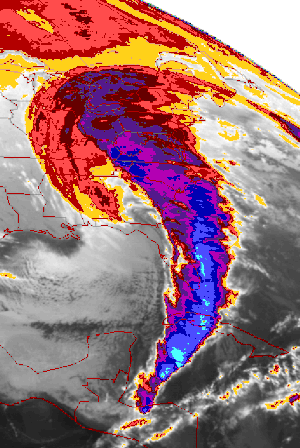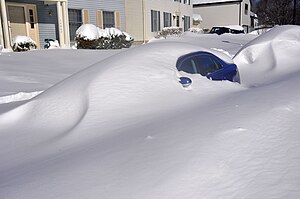
The Northeast snowfall impact scale (NESIS) is a scale used to categorize winter storms in the Northeast United States. [1] The scale was developed by meteorologists Paul Kocin and Louis Uccellini, and ranks snowstorms from category 1 ("notable") to category 5 ("extreme"). Only two historical blizzards, the 1993 Storm of the Century and the North American blizzard of 1996 are rated in the 5 "extreme" category. The scale differs from the Saffir–Simpson hurricane scale and Fujita scale, which are used to classify tropical cyclones and tornadoes, respectively, in that it takes into account the number of people affected by the storm. [2] The scale, as devised, is intended chiefly to assess past storms rather than assist in forecasts. This scale takes into account population size of the Northeast, and thus snowfall amounts are often not that high. [3]
List





There are two available values for NESIS. The original values that Paul Kocin and Louis Uccellini computed for storms in their original 2004 work "A Snowfall Impact Scale Derived From Northeast Storm Snowfall Distributions" and the NESIS storm values recomputed using some different data and differing methods by the National Climatic Data Center (NCDC) in 2005 to productionize their work for assigning values to future storm storms beyond Kocin/Uccellini work. Kocin/Uccellini originally computed NESIS values for 70 storms from 1888 to 2003. The NCDC recomputed NESIS values for 30 of the same storms and has since for newer storms beyond 2003.
Storms pre-2005 use the Kocin/Uccellini rating and description. Storms 2005 and onward use the NCDC rating and description. NOAA's National Centers for Environmental Information publishes a list of storms with ratings and other information, starting with the March 1956 storm.
| Date | Original NESIS | NCDC NESIS | Category | Description |
|---|---|---|---|---|
| March 11–14, 1888 | 08.34 | - | 4 | Crippling |
| February 11–14, 1899 | 08.11 | - | 4 | Crippling |
| December 26–27, 1947 | 03.50 | - | 2 | Significant |
| February 16–17, 1952 | 02.17 | - | 1 | Notable |
| March 16–17, 1956 | 02.93 | - | 2 | Significant |
| March 18–19, 1956 | 02.23 | 01.87 | 1 | Notable |
| December 3–5, 1957 | 01.32 | - | 1 | Notable |
| February 14–17, 1958 | 05.98 | 06.25 | 3 | Major |
| March 18–21, 1958 | 03.92 | 03.51 | 2 | Significant |
| March 12–13, 1959 | 03.64 | - | 2 | Significant |
| February 14–15, 1960 | 04.17 | - | 3 | Major |
| March 2–5, 1960 | 07.63 | 08.77 | 4 | Crippling |
| December 11–13, 1960 | 04.47 | 04.53 | 3 | Major |
| January 18–21, 1961 | 03.47 | 04.04 | 2 | Significant |
| February 2–5, 1961 | 06.24 | 07.06 | 4 | Crippling |
| December 23–25, 1961 | 01.37 | - | 1 | Notable |
| February 14–15, 1962 | 01.59 | - | 1 | Notable |
| March 6–7, 1962 | 02.76 | - | 4 | Crippling |
| December 22–23, 1963 | 03.17 | - | 2 | Significant |
| January 11–14, 1964 | 05.74 | 06.91 | 3 | Major |
| February 19–20, 1964 | 02.39 | - | 1 | Notable |
| January 16–17, 1965 | 01.95 | - | 1 | Notable |
| January 22–23, 1966 | 04.45 | - | 3 | Major |
| January 29–31, 1966 | 05.19 | 05.93 | 4 | Crippling |
| December 23–25, 1966 | 03.79 | 03.81 | 2 | Significant |
| February 5–7, 1967 | 03.82 | 03.50 | 2 | Significant |
| March 21–22, 1967 | 01.20 | - | 2 | Significant |
| February 8–10, 1969 | 03.34 | 03.51 | 2 | Significant |
| February 22–28, 1969 | 04.01 | 04.29 | 3 | Major |
| December 25–27, 1969 | 05.19 | 06.29 | 3 | Major |
| December 31, 1970–January 1, 1971 | 02.10 | - | 1 | Notable |
| March 3–5, 1971 | 03.73 | - | 2 | Significant |
| November 25–27, 1971 | 02.33 | - | 1 | Notable |
| February 18–20, 1972 | 04.19 | 04.77 | 3 | Major |
| January 16–18, 1978 | 04.10 | - | 3 | Major |
| January 19–21, 1978 | 05.90 | 06.53 | 4 | Crippling |
| February 5–7, 1978 | 06.25 | 05.78 | 3 | Major |
| February 17–19, 1979 | 04.42 | 04.77 | 3 | Major |
| January 13–15, 1982 | 03.08 | - | 2 | Significant |
| April 6–7, 1982 | 03.75 | 03.35 | 2 | Significant |
| February 10–12, 1983 | 06.28 | 06.25 | 4 | Crippling |
| March 8–9, 1984 | 01.29 | - | 1 | Notable |
| March 28–29, 1984 | 01.86 | - | 1 | Notable |
| January 1–2, 1987 | 02.26 | - | 1 | Notable |
| January 21–23, 1987 | 04.93 | 05.40 | 3 | Major |
| January 25–26, 1987 | 01.70 | 01.19 | 1 | Notable |
| February 22–23, 1987 | 01.46 | 01.46 | 1 | Notable |
| January 7–8, 1988 | 04.85 | - | 3 | Major |
| December 26–27, 1990 | 01.56 | - | 1 | Notable |
| December 10–12, 1990 | 03.10 | - | 2 | Significant |
| March 12–14, 1993 | 12.52 | 13.20 | 5 | Extreme |
| January 3–5, 1994 | 02.87 | - | 2 | Significant |
| February 8–12, 1994 | 04.81 | 05.39 | 3 | Major |
| March 2–4, 1994 | 03.46 | - | 2 | Significant |
| February 2–4, 1995 | 03.51 | 01.43 | 2 | Significant |
| December 19–20, 1995 | 03.32 | - | 2 | Significant |
| January 6–8, 1996 | 11.54 | 11.78 | 5 | Extreme |
| February 2–4, 1996 | 02.03 | - | 1 | Notable |
| February 16–17, 1996 | 01.65 | - | 1 | Notable |
| March 31–April 1, 1997 | 02.37 | 02.29 | 1 | Notable |
| March 14–15, 1999 | 02.20 | - | 1 | Notable |
| January 24–26, 2000 | 03.14 | 02.52 | 2 | Significant |
| December 30–31, 2000 | 02.48 | 02.37 | 1 | Notable |
| March 3–5, 2001 | 03.53 | - | 2 | Significant |
| December 4–5, 2002 | 01.99 | - | 1 | Notable |
| December 24–25, 2002 | 04.42 | - | 3 | Major |
| January 3–4, 2003 | 02.65 | - | 2 | Significant |
| February 6–7, 2003 | 01.18 | - | 1 | Notable |
| February 15–18, 2003 | 08.91 | 07.50 | 4 | Crippling |
| January 21–24, 2005 | - | 06.80 | 4 | Crippling |
| February 12–13, 2006 | - | 04.10 | 3 | Major |
| February 12–15, 2007 | - | 05.63 | 3 | Major |
| March 15–18, 2007 | - | 02.54 | 2 | Significant |
| March 1–3, 2009 | - | 01.59 | 1 | Notable |
| December 18–21, 2009 | - | 03.99 | 2 | Significant |
| February 4–7, 2010 | - | 04.38 | 3 | Major |
| February 9–11, 2010 | - | 04.10 | 3 | Major |
| February 25–27, 2010 | - | 05.46 | 3 | Major |
| December 26–27, 2010 | - | 04.92 | 3 | Major |
| January 9–13, 2011 | 05.31 | 3 | Major | |
| January 26–27, 2011 | - | 02.17 | 1 | Notable |
| February 1–3, 2011 | - | 05.30 | 3 | Major |
| October 28–30, 2011 | - | 01.75 | 1 | Notable |
| February 7–10, 2013 | - | 04.35 | 3 | Major |
| March 4–9, 2013 | - | 03.05 | 2 | Significant |
| December 13–16, 2013 | - | 02.95 | 2 | Significant |
| December 30, 2013–January 3, 2014 | - | 03.31 | 2 | Significant |
| January 20–22, 2014 | - | 01.26 | 1 | Notable |
| January 29–February 4, 2014 | - | 04.08 | 3 | Major |
| February 11–14, 2014 | - | 05.28 | 4 | Crippling |
| November 26–28, 2014 | - | 01.56 | 1 | Notable |
| December 9–14, 2014 | - | 01.49 | 1 | Notable |
| January 25–28, 2015 | - | 02.62 | 3 | Major |
| January 29–February 3, 2015 | - | 05.42 | 3 | Major |
| February 8–11, 2015 | - | 01.32 | 1 | Notable |
| January 22–24, 2016 | - | 07.66 | 5 | Extreme |
| March 12–15, 2017 | - | 05.03 | 3 | Major |
| January 3–5, 2018 | - | 02.27 | 1 | Notable |
| March 1–3, 2018 | - | 01.65 | 1 | Notable |
| March 5–8, 2018 | - | 03.45 | 2 | Significant |
| March 11–15, 2018 | - | 03.16 | 2 | Significant |
| March 20–22, 2018 | - | 01.63 | 1 | Notable |
| December 14–18, 2020 | - | 03.21 | 2 | Significant |
| January 30–February 3, 2021 | - | 04.93 | 3 | Major |
| January 1-3, 2022 | - | 01.06 | 1 | Notable |
See also
- Regional snowfall index
- List of regional snowfall index category 5 winter storms
- List of regional snowfall index category 4 winter storms
- List of blizzards
Footnotes
- ^ Staff Writer (February 1, 2006). "Scientists devise new scale to rate snowstorms". The Reading Eagle. Retrieved March 1, 2010.
- ^ "The Northeast Snowfall Impact Scale (NESIS)". National Climatic Data Center (NCDC). Archived from the original on January 5, 2011. Retrieved March 1, 2010.
- ^ Kocin and Uccellini, pp. 269–270
References
- Paul J. Kocin and Louis W. Uccellini (2004). Northeast Snowstorms. American Meteorological Society. ISBN 1-878220-64-0.
- "The Northeast Snowfall Impact Scale (NESIS)". National Climatic Data Center (NCDC). Retrieved December 18, 2015.
- Development of an Operational Northeast Snowfall Impact Scale by Michael F. Squires and Jay H. Lawrimore